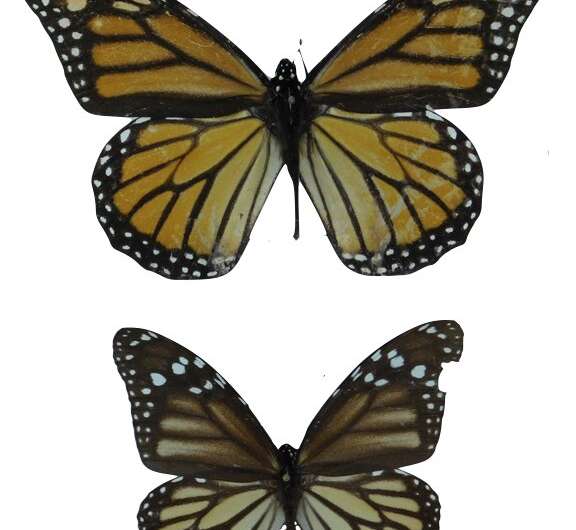Two centuries of Monarch butterflies show evolution of wing length

North America's beloved Monarch butterflies are known for their annual, multi-generation migrations in which individual insects can fly for thousands of miles. But Monarchs have also settled in some locations where their favorite food plants grow year round, so they no longer need to migrate.
Micah Freedman, a graduate student at the Center for Population Biology at UC Davis, took a deep dive into museum collections to see how migration has shaped the species. Monarchs are native to North America, but have also established non-migrating populations in the Caribbean, Central and South America, and islands in the Pacific and Atlantic oceans. These island-hopping butterflies may have been blown by storms before being lucky enough to reach dry land.
Monarchs that established new, non-migrating populations also had those larger wings. But over time, the wings of these colonists got smaller.
Selection at work in opposing directions
The shift between longer and shorter wings shows two opposite selection forces at work, Freedman and colleagues wrote in a paper published this week in Proceedings of the National Academy of Sciences. Migration selects for longer, larger forewings while non-migration seems to relax this and lead to smaller wings.
Alternatively, wing size could be influenced by other environmental factors depending on where butterflies are hatched and grow up. To test this, Freedman raised Monarch butterflies from non-migrating populations in Hawaii, Guam, Australia and Puerto Rico outdoors in Davis, California alongside native migrating Monarchs. The non-migrating butterflies retained their smaller wings, showing that the effect is due to genetics and not the rearing environment.
"Our findings provide a compelling example of how migration-associated traits may be favored during the early stages of range expansion, and also the rate of reductions in those same traits upon loss of migration," the authors wrote.
Freedman's coauthors on the study are Professor Sharon Strauss and Associate Professor Santiago Ramirez, Department of Evolution and Ecology and Professor Hugh Dingle, Department of Entomology and Nematology.
More information: Micah G. Freedman et al, Two centuries of monarch butterfly collections reveal contrasting effects of range expansion and migration loss on wing traits, Proceedings of the National Academy of Sciences (2020). DOI: 10.1073/pnas.2001283117
Journal information: Proceedings of the National Academy of Sciences
Provided by UC Davis


















